TANZANIA
Economy

Economy
Popular destinations TANZANIA
| Pemba | Zanzibar |
Economy
General
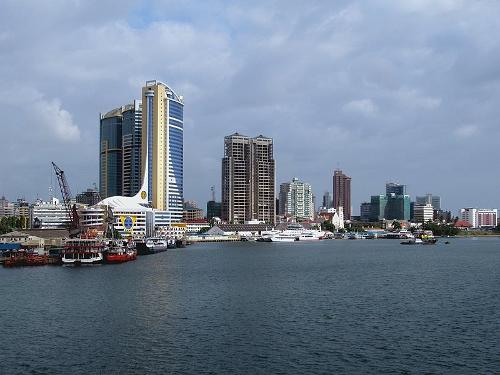 Dar Es Salaam Economic Center of TanzaniaPhoto: Davis Stanley CC 2.0 Generic no changes made
Dar Es Salaam Economic Center of TanzaniaPhoto: Davis Stanley CC 2.0 Generic no changes made
Until the end of the 1970s, Tanzania was considered a model developing country, partly because of the large amounts of development aid from abroad. At the beginning of the 1980s, however, economic decline struck due to declines in the world market of important export products such as coffee and cotton, and an underdeveloped transport and communications sector as the main cause. In 1986 a reform agreement was signed with the IMF and the World Bank, whereby the agricultural sector was to serve as the basis and engine of development in other sectors. Liberalization of the economy was initiated and foreign investment was encouraged. However, developments are still very slow.
At the end of the nineties, the economy took a negative turn due to a sharp drop in exports. Tanzania was granted the status of Heavily Indebted Poor Country by the IMF in 1999. This resulted in a cancellation of the external debt.
Because the economy is one quarter dependent on the agricultural sector, the economy is very vulnerable. 80% of the working population is employed in agriculture, horticulture and forestry, livestock farming and fishing. Heavy rainfall or extreme drought means a greatly reduced production, which in turn weakens economic growth.
In the East African Development Strategy, Tanzania, Kenya and Uganda have agreed that a customs union and a common market will be realized.
Despite everything, Tanzania is currently one of the poorest countries in the world, where one fifth of the population lives below the poverty line. Most of the poor population lives in rural areas, but the number of urban poor is also growing rapidly.
It is estimated that only about half of the population has clean drinking water and diseases such as malaria, tuberculosis, diarrhea and infections are common. The high death rate is also negatively affected by AIDS; It is estimated that almost 10% of the population is HIV positive, especially the age group between 15 and 49 years. in recent years economic growth has picked up by an average of 6-7% per year (2017). The GDP per capita is $ 3,200 (2017).
Agriculture, livestock, forestry and fishing
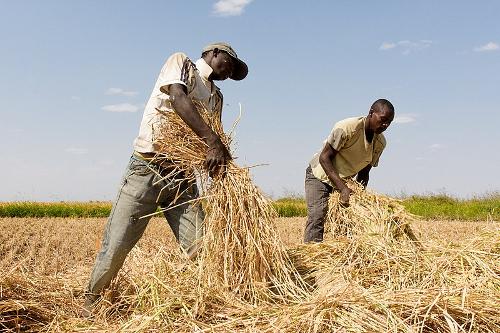 Rice farming TanzaniaPhoto: Michaelgoima CC 4.0 International no changes made
Rice farming TanzaniaPhoto: Michaelgoima CC 4.0 International no changes made
The agricultural sector contributes approximately 23.4% to the GNP (2017) and provides employment to 66.9% of the working population. In addition to self-sufficiency, this sector makes a large contribution to export income. Most farmers have a piece of land of no more than 2 ha. Important agricultural areas are the coastal plain, the areas with volcanic soil in the north around Tanga, Moshi and Arusha. Furthermore, the area around Lake Victoria and the southwest.
The main agricultural exports are coffee, cotton, tea and cashews. The once thriving sisal production in Morogoro Province collapsed in the 1980s. Flower cultivation is a relatively new commercial market, both for the production of seed and for the export of cut flowers to Europe. Among other things, wheat is grown on the slopes of the Ngorongoro highlands, while a lot of corn is produced in the drier areas. In the coastal areas, copra is harvested on commercial coconut plantations, from which coconut oil, coconut cake for livestock and other by-products are extracted.
The area around Moshi, especially the lower area around Kilimanjaro, is world famous for the Arabica coffee, the best coffee grown in Tanzania. Most of the plantations are owned by members of the Chagga tribe.
Cloves are grown on Zanzibar and in particular Pemba, about 80% of the world production. Vanilla, ginger, nutmeg and lemongrass are also grown on a fairly large scale on Pemba.
Livestock farming occurs mainly in the north and central highlands and is carried out by nomads, mainly for their own use.
Approx. 45% of the land is covered with forest, where only a small part can be exploited in a commercially responsible manner. Important for export are ebony, mahogany and sandalwood; by-products are beeswax, resin and gum. As more and more land is cleared for agriculture and the production of firewood and charcoal, deforestation is an increasing problem.
Tanzania has plenty of fish-rich waters, but a shortage of modern ships and processing capacity. Of the fishery, the inland fisheries on Lake Victoria and Lake Tanganyika are important. In Kibirizi and Kigoma along Lake Victoria, sardine fishing is the main industry. Although tilapia is the most commonly eaten, Nile perch, which was only released in Lake Victoria in 1956, accounts for 75% of the total catch.
Sea fishing is still little developed. A vibrant domestic trade in deep-sea fish has developed along the coast, including marlin and tuna, as well as octopus, crab and snapper.
Mining
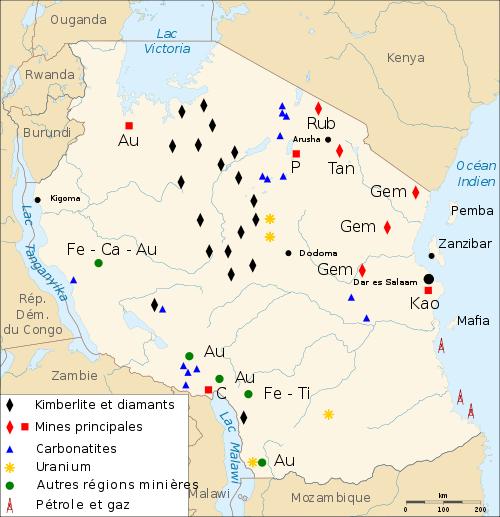 Tanzania natural resources mapPhoto: Shakki CC 3.0 Unported no changes made
Tanzania natural resources mapPhoto: Shakki CC 3.0 Unported no changes made
Mineral extraction is owned by the State Mining Corporation, but does not yet contribute much to GDP, although it is one of the fastest growing sectors in the Tanzanian economy. Tanzania's soil contains many minerals, including coal, iron ore, diamond, gold, tanzanite, salt, gypsum nickel and cobalt. Companies from Western countries have recently made major investments in the mining sector. For example, the large gold mine of Bulyanhulu is in Canadian hands and a large part of the profit goes abroad. The local communities therefore benefit very little and that has regularly led to riots and even bloody confrontations.
The large number of mines in Tanzania mainly produces gold. Tanzania has the third largest gold mine in Africa, with a yield of more than 10,000 kilos per year.
Tanzanite is a light brown semi-precious stone, which was only discovered in 1967. After heating, the stone changes into a beautiful purple-blue color. The only mine in the world that produces tanzanite is located in Mererani. The United States is the largest buyer with 80%.
Industry
 Sisal products TanzaniaPhoto: Achim Rachka CC 3.0 Unported no changes made
Sisal products TanzaniaPhoto: Achim Rachka CC 3.0 Unported no changes made
The industrial sector accounted for 28.6% of GDP in 2017. The industry is mainly concerned with the processing of the agricultural products and is concentrated in Dar es Salaam, Moshi, Tanga, Arusha, Mwanza, Morogoro and Dodoma. In addition, there are a petroleum and petrochemical refinery, cement, fertilizer, tobacco, paper and textile mills.
Growth sectors are food production, beverages, textiles, paints and sisal ropes.
Energy supply
 Logo Tanesco, TanzaniaPhoto: Public domain
Logo Tanesco, TanzaniaPhoto: Public domain
Power generation and distribution are provided by the Tanganyika Electricity Supply Company (Tanesco). Electricity is mainly (approx. 75%) supplied by hydropower plants. Other important sources of energy are imported petroleum and coal. Little use is made of wind and solar energy.
A sisal biogas plant is opened in 2004 in the Tanga region. Tanzania thus becomes the first East African country to generate electricity from sisal waste.
Trade
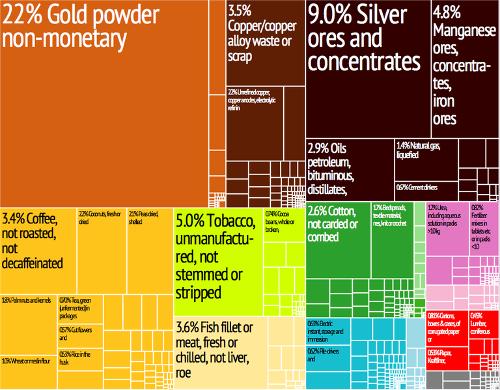 Tanzania ExportPhoto: R. Haussmann, Cesar Hidalgo, et.al CC 3.0 no changes made
Tanzania ExportPhoto: R. Haussmann, Cesar Hidalgo, et.al CC 3.0 no changes made
The government is heavily involved in foreign trade. For example, only since 1996 there has been a total lifting of the import and export restrictions in force. Although the trade deficit is gradually narrowing, it was still close to $ 3 billion in 2017.
Exported are: coffee, cotton, cloves, tea, tobacco, cashew nuts, gold, diamond, sisal and products from the processing industry. Main buyers are India (especially cashews) Kenya, China, South Africa and the EU countries, The total value of exports was $ 5 billion.
Imported are machinery, vehicles, semi-finished products (petroleum) and foodstuffs. Main suppliers are China, India, UAE and South Africa. The total value of the imports was $ 7.9 billion.
Traffic
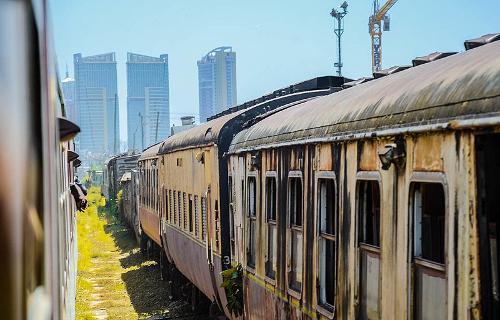 Tanzania Railways CorporationPhoto: Erasmus Kamugisha CC 4.0 International no changes made
Tanzania Railways CorporationPhoto: Erasmus Kamugisha CC 4.0 International no changes made
The Tanzanian road network is widespread, but only a small part of the total road network, in total approx. 100,000 km, is asphalted. With the Integrated Roads Program, the Tanzanian government is investing heavily in the road network. At the moment, the main cities are easily accessible by road, although the road condition is not always good.
The Tanzam Highway runs from Dar es Salaam via Morogoro and Iringa to the Zambian capital Lusaka. The Tanzam Highway cuts through Mikumi National Park.
The Tanzania Railways Corporation is the state rail company and the governor of 3000 km of railways. The main railway lines are the line from Dar es Salaam to Kigoma, the line from Tanga to Arusha and the line between Dar es Salaam and the Zambian city of Kapiri Mposhi, which gives the country a rail connection to the whole of southern Africa. The railway is operated by the Tanzania-Zambia Railway Authority.
Since 1970, the Tazara Railway has run through Tanzania and Zambia, for 1,860 km, starting in Dar es Salaam and ending in Kapiri Mposhi in Zambia. The collapse of the Zambian copper industry puts the future of this railway at stake.
The port of Dar es Salaam has great significance for the economy of Tanzania, but also for the neighboring countries Zambia, Uganda, Rwanda and Burundi. Other major ports are those of Tanga and Mtwara. Smaller ports on the Indian Ocean are Kwale, Kilwa, Lindi, Mafia, Bagamoyo and Pangani.
The national airline is Air Tanzania, privatized since 2002. Liberalization of the market has created some new airlines that compete with Air Tanzania on domestic flights.
Dar es Salaam, Zanzibar, Mwanza and Arusha (due to the tourist attraction of Kilimanjaro) have international airports. There are also a large number of smaller airports and landing strips at many national parks.
Sources
Heale, J. / Tanzania
Marshall Cavendish
Tanzania
Cambium
Vlugt, B. / Kenia, Tanzania, Zanzibar
Gottmer/Becht
Waard, P. de / Reishandboek Tanzania
Elmar
CIA - World Factbook
BBC - Country Profiles
Copyright: Team The World of Info